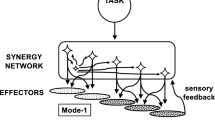Abstract
It is demonstrated, that a two-joined arm performing goal directed movements is controllable (a) by two central pattern generators (CPG) representing sampled data control, each referring to one joint, initiated for exactly one period, and producing the angular movement width about this joint, and (b) by reflex-like processes operating continuously with respect to time. The latter eliminate the effects of dynamic coupling, gravity, inertia, and mechanical impedance on the movement by ‘proprioceptive feedforward’ of position, velocity and acceleration signals, thus enabling the CPGs to handle the arm segments as if they were independent and free from forces. Higher ordered centers (with respect to the CPGs) therefore only need to control the kinematics, not dynamics, of the arm.
Similar content being viewed by others
References
Carew ThJ (1981) Spinal Cord I: muscles and muscle receptors. In: Kandel ER, Schwartz JH (eds) Principles of neural science 2nd edn. Edward Arnold, London.
Eckmiller R (1990) Neural computers for motor control. In: Eckmiller R (ed) Advanced neural computers. Elsevier, North Holland.
Freund HJ (1986) Time control of hand movements. In: Freund HJ, Büttner U, Cohen B, Noth J (eds) The oculomotor and skeletalmotor systems. Prog Brain Res 64:287–294.
Grillner S (1985) Neural control of vertebrate locomotion — central mechanisms and reflex interaction with special reference to the cat. In: Barnes WJP, Gladden NH (eds) Feedback and motor control in invertebrates and vertebrates. Groom-Helm, London.
Holst E von, Mittelstaedt H (1950) Das Reafferenzprinzip. Naturwissenchaften 37:464–576.
Holst E von, Mittelstaedt H (1973) The reafference principle. Interaction between the central nervous system and the periphery. In: Selected papers of Erich von Holst: the behavioural physiology of animals and man, vol 1. Methuen, London (Translated from German by R. Martin), pp 139–173.
Kalveram K Th (1981) Erwerb sensumotorischer Koordinationen unter störenden Umwelteinflüssen: Ein Beitrag zum Problem des Erlernens von Werkzeuggebrauch (Engl. Titel: Acquiring sensorimotor coordinations under disturbed feedback. A contribution to the problem of learning to handle a tool). In: Tent L (ed) Erkennen, Wollen, Handeln. Festschrift für Heinrich Düker. Hogrefe, Göttingen, pp 336–348.
Kalveram K Th (1990) A neural network acquiring the inverse of a tool or limb transformation by “self-imitation learning”. Poster at the ICNC — 10th Cybernetic Congress of the DGK, Düsseldorf. (Reprint available on request from the author).
Kalveram K Th (1991) Pattern generating and reflex-like processes controlling aiming movements in the presence of inertia, damping and gravity. A theoretical note. Biol Cybern 64:413–419.
Kawato M (1990) Feedback-error-learning neural network for supervised motor learning. In: Eckmiller R (ed) Advanced neural computers. Elsevier, North Holland.
Kuperstein M, Rubinstein J (1989) Implementation of an adaptive neural controller for sensory-motor coordination. Control Syst 3:25–30.
Lacquaniti F, Soechting JF (1986) Simulation studies on the control of posture and movement in a multi-jointed limb. Biol Cybern 54:367–378.
Martin JH (1981) Somatic sensory system I: Receptor physiology and submodality coding. In: Kandel ER, Schwartz JH (eds) Principles of neural science, 2nd edn. Edward Arnold, London.
McCloskey DI (1981) corollary discharges: Motor commands and perception. In: Brooks VB (ed) Motor control, part 2. In: Handbood of physiology, Sect. 1: The nervous system, vol II. Americal Physiological Society, Bethesda, Md.
Mittelstaedt H (1990) Basic solutions to the problem of head-centric visual localization. In: Warren R, Wertheim AH (eds) The perception and control of self-motion. Erlbaum, Hillsdale.
Miyamoto H, Kawato M, Setoyama T, Suzuki R (1988) Feedback-error-learning neural network for trajectory control of a robotic manipulator. Neural Networks 1:251–265.
Ritter HJ, Martinetz TM, Schulten KJ (1989) Topology-conserving maps for learning visuo-motor-coordination. Neural Networks 2:159–168.
Saltzman E (1979) Levels of sensorimotor representation. J Math Psychol 20:91–163.
Saltzman E, Kelso JAS (1987) Skilled actions: A task-dynamic approach. Psychol Rev 94:84–106.
Sperry RW (1950) Neural basis of the spontaneous optokinetic response produced by visual neural inversion. J Comp Physiol 43:482–489.
Author information
Authors and Affiliations
Rights and permissions
About this article
Cite this article
Kalveram, K.T. Controlling the dynamics of a two-joined arm by central patterning and reflex-like processing. Biol. Cybern. 65, 65–71 (1991). https://doi.org/10.1007/BF00197291
Received:
Accepted:
Issue Date:
DOI: https://doi.org/10.1007/BF00197291




